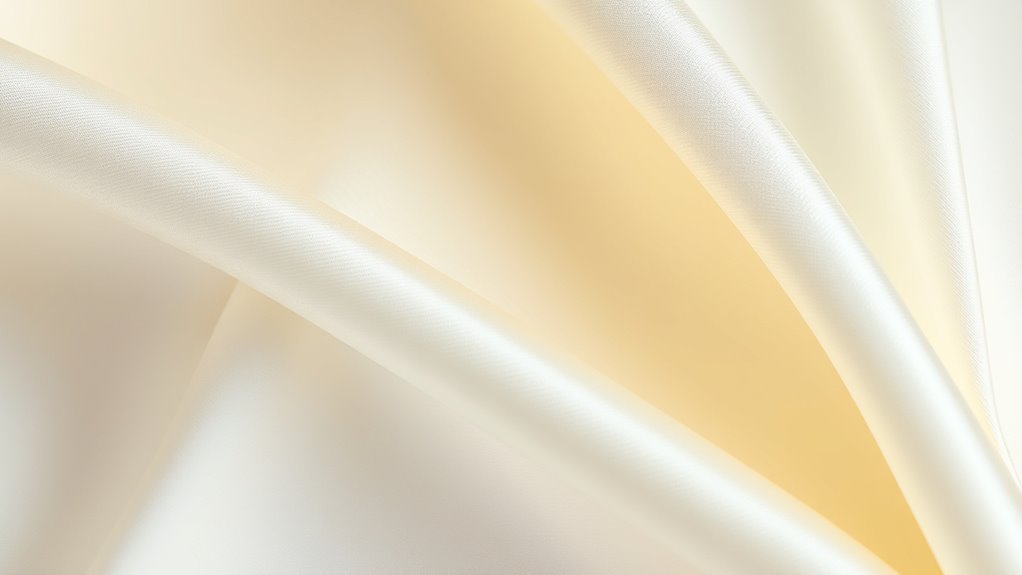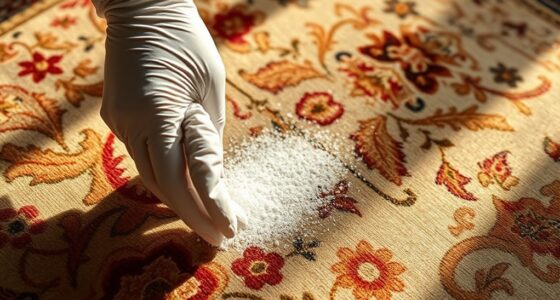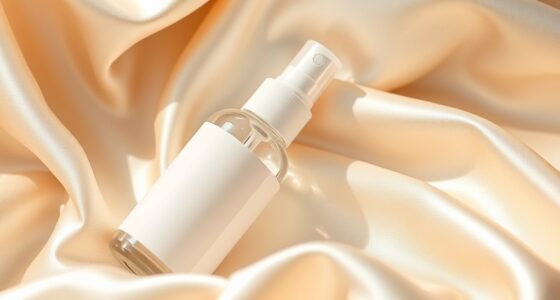Optical brighteners are chemicals that reflect UV light, making fabrics look whiter and brighter. Over time, they can cause silk to yellow because of chemical interactions, environmental factors, and UV exposure that weaken fibers and promote oxidation. Residues from cleaning agents or pollutants can accelerate this process, leading to discoloration. If you want to understand how to prevent yellowing and preserve silk’s natural beauty, discover the key factors involved in this complex interaction.
Key Takeaways
- Optical brighteners can cause chemical reactions with silk, leading to yellowing over time.
- UV exposure breaks down brightener molecules, resulting in discoloration and yellowing of silk.
- Residue buildup from cleaning products or pollutants accelerates oxidation, causing silk to yellow.
- Brighteners may alter silk’s natural pH, weakening fibers and promoting yellowing.
- Environmental factors like humidity and pollutants facilitate degradation and long-term yellowing of silk containing brighteners.
What Are Optical Brighteners and How Do They Work?
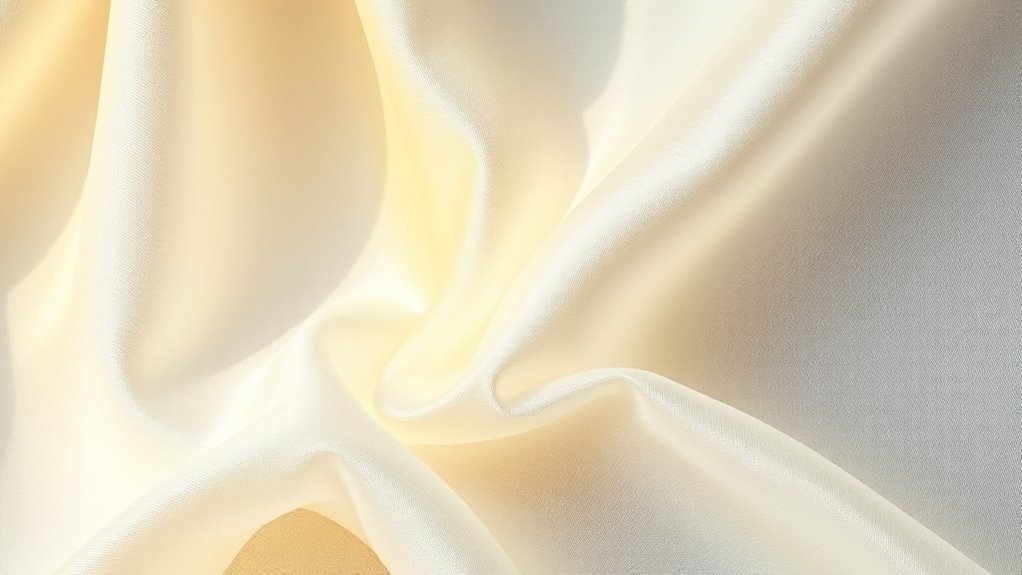
Have you ever wondered how your whites stay so bright and vibrant? Optical brighteners work by absorbing ultraviolet light and converting it into visible blue or violet light through a process called fiber fluorescence. When these chemicals are added during manufacturing or laundry, they dye absorption occurs on the fabric fibers, giving them a whiter appearance. The brighteners embed into the fibers, reflecting more light and making clothes look fresher. They don’t actually bleach or remove stains but enhance the fabric’s brightness by tricking your eyes into perceiving whiteness. This optical illusion relies on their ability to bond with fibers and emit visible light. Additionally, their ability to adhere to fabric fibers is crucial for maintaining their effectiveness over multiple washes, although they may diminish over time. Proper formulation and fiber compatibility are essential for their sustained performance. To ensure the longevity of optical brighteners, understanding their chemical stability during laundry is also important. That’s why your laundry looks brighter and your whites stay so striking, even after multiple washes.
The Role of Optical Brighteners in Textile Whitening
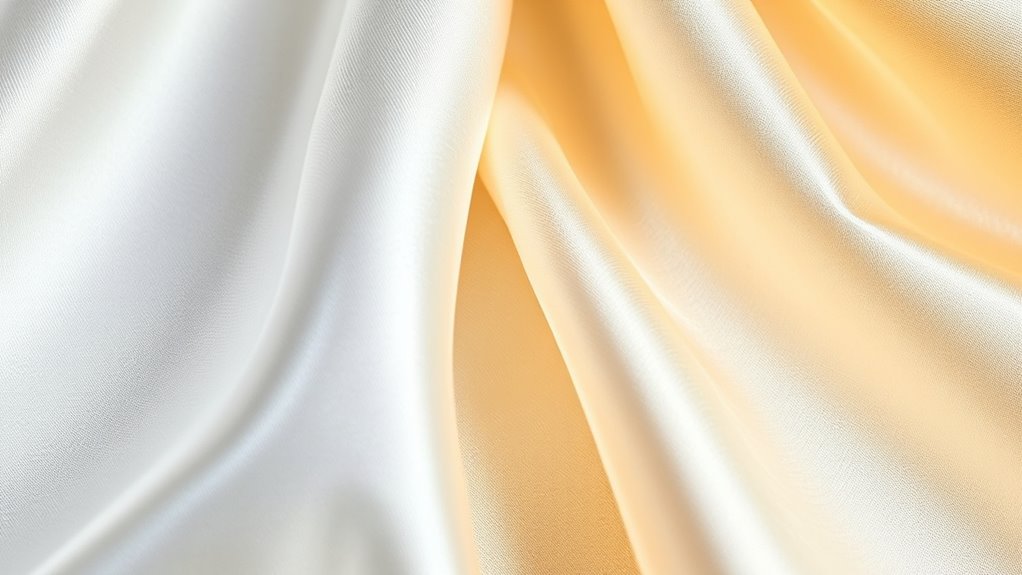
Optical brighteners play a crucial role in textile whitening by enhancing the appearance of fabrics without altering their actual color or removing stains. They work by absorbing ultraviolet light and emitting visible blue fluorescence, making fabrics appear whiter and brighter. However, dye migration can occur if brighteners are not compatible with the fiber type, causing uneven coloration or fading over time. Fiber compatibility is essential because some fibers, like silk, may absorb brighteners differently than cotton or polyester, affecting the whitening effectiveness and longevity. By selecting the right optical brighteners for specific fibers, manufacturers can ensure consistent brightness and minimize issues like yellowing or discoloration. Proper formulation and application are key to achieving a vibrant, long-lasting whiteness in textiles.
Chemical Interactions Between Brighteners and Silk Fibers
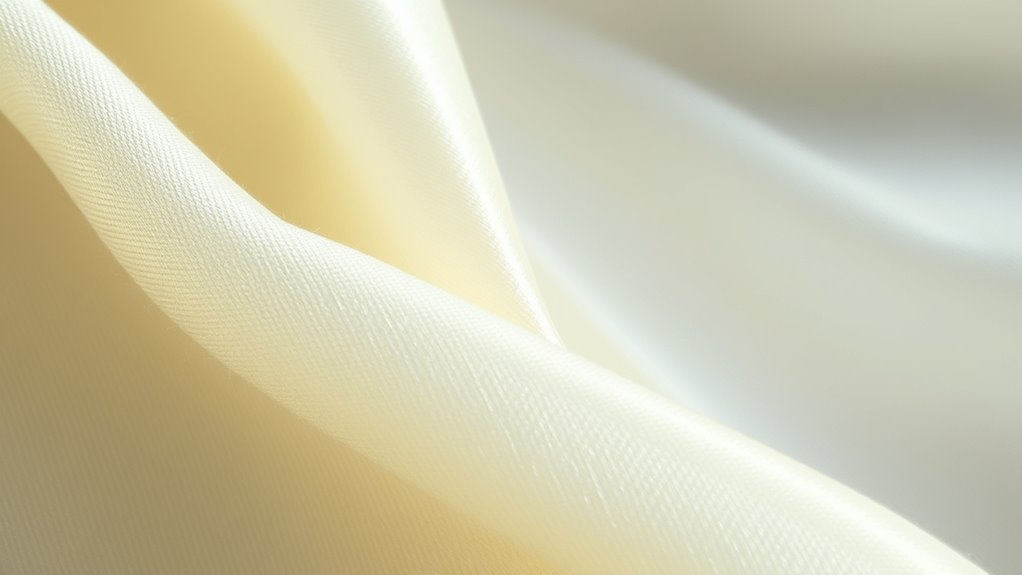
When optical brighteners interact with silk fibers, chemical bonds can form that influence their effectiveness and durability. UV light can cause these bonds to break or change, affecting how the fibers reflect light. Additionally, oxidation processes may alter the brighteners’ structure, impacting their long-term performance on silk. Furthermore, understanding the chemical interactions involved can help in developing more durable and stain-resistant silk treatments. Recognizing the chemical stability of brighteners under various environmental conditions is essential for improving their longevity on delicate fabrics. The environmental factors such as humidity and exposure to pollutants also play a significant role in the degradation process of optical brighteners on silk. Advances in material science can lead to the development of more resilient brightening agents that withstand environmental stressors.
Chemical Bond Formation
Chemical bond formation between optical brighteners and silk fibers involves specific interactions that enhance fluorescence and dye affinity. These bonds contribute to the molecular stability of the brighteners on the silk surface, ensuring they stay attached during washing and use. The bonding mechanisms include hydrogen bonds and van der Waals forces, which improve dye affinity by allowing the brighteners to embed securely within the silk’s protein structure. Stronger bonds lead to better fluorescence and longer-lasting effects. Additionally, the presence of quality materials can influence how well these bonds form and persist over time. Moreover, understanding the industry trends in chemical formulations helps in developing brighter and more durable treatments. Considering the impact of appliance maintenance plans on material preservation can also be relevant when assessing long-term fabric care. However, if these bonds are too weak or unstable, it can cause the brighteners to degrade or yellow over time. Understanding this balance is essential for designing brighteners that maintain their effectiveness without compromising the integrity of silk fibers.
UV Light Effects
Exposure to UV light can considerably influence the chemical interactions between optical brighteners and silk fibers. UV exposure accelerates UV degradation and photobleaching effects, causing brighteners to lose their vibrancy over time. As UV rays penetrate silk, they break down the molecules responsible for fluorescence, leading to dullness and discoloration. This process can evoke strong emotions, making you feel frustrated when your silk items fade unexpectedly. Consider these points:
- You might notice your silk appearing dull after prolonged sun exposure.
- Brighteners may lose their ability to reflect light, diminishing silk’s brightness.
- UV degradation can trigger irreversible yellowing, affecting your cherished garments.
- Understanding photo-oxidation processes can help you better protect your silk from UV damage, prolonging its beauty and preventing yellowing.
- Implementing protective measures like UV-blocking treatments can significantly slow down the yellowing process and preserve silk’s original luster.
- Proper storage and avoiding direct sunlight can further mitigate UV-induced damage, helping maintain silk’s vibrant appearance over time.
Oxidation Processes
Oxidation processes are key to understanding how optical brighteners interact with silk fibers. When exposed to environmental pollutants like oxygen and pollutants, brighteners can undergo oxidation, leading to chemical changes that cause yellowing over time. This oxidation can weaken silk fibers and promote dye migration, where dyes and brighteners shift from their original positions, dulling the fabric’s brightness. The following table highlights common factors influencing oxidation:
| Factor | Effect | Result |
|---|---|---|
| Environmental Pollutants | Accelerates oxidation | Faster yellowing |
| UV Light Exposure | Promotes chemical reactions | Increased dye migration |
| Humidity | Facilitates oxidation | Fiber degradation |
| Brightener Composition | Susceptibility to oxidation | Yellowing over time |
Understanding these interactions helps in developing treatments to slow silk yellowing caused by oxidation.
Factors That Accelerate Yellowing in Silk Fabrics
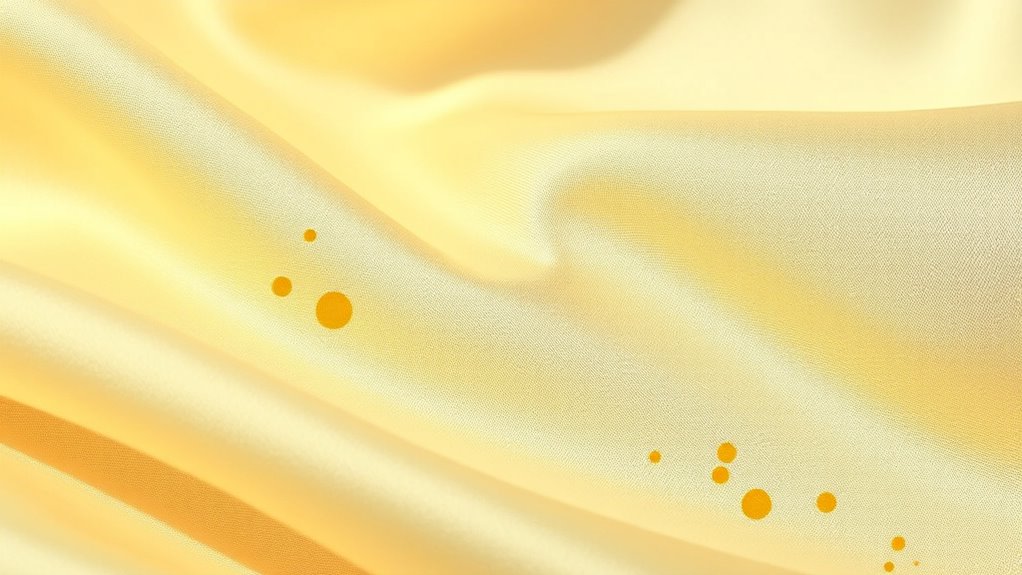
Sunlight exposure can quickly cause silk fabrics to yellow over time, especially if left in direct sunlight. Chemical residues from cleaning products or treatments can also weaken the fibers and speed up discoloration. Understanding these factors helps you protect your silk and maintain its brightness longer.
Sunlight Exposure Effects
When silk fabrics are subjected to prolonged sunlight, the ultraviolet (UV) rays penetrate the fibers and break down their chemical structure. This UV degradation accelerates yellowing and weakens the fabric over time. As you expose silk to sunlight, you risk:
- Fading of vibrant colors, dulling the fabric’s beauty.
- Increased Residue buildup, which traps dirt and oils, intensifying discoloration.
- Structural damage, causing fibers to weaken and become brittle.
The combination of UV degradation and residue buildup makes silk more vulnerable to yellowing. Sunlight not only damages the fabric’s surface but also promotes chemical changes, making it essential to limit exposure to preserve silk’s natural luster and prevent premature aging.
Chemical Residue Impact
Residual chemicals from cleaning products, dyes, or environmental pollutants can considerably speed up the yellowing process in silk fabrics. When these residues build up on silk, they trigger chemical reactions that weaken the fibers and cause discoloration. Over time, residue buildup acts as a catalyst for oxidation, intensifying the yellow hue. Harsh cleaning agents or improperly rinsed dyes leave behind traces that accelerate degradation. Environmental pollutants like smoke or pollution particles can also settle on the fabric, promoting chemical reactions that promote yellowing. To protect your silk, it is crucial to thoroughly rinse fabrics after cleaning and avoid exposure to pollutants. Additionally, using gentle cleaning methods helps prevent residue buildup and preserves the fabric’s natural beauty. Regular inspection and maintenance can also help identify early signs of discoloration caused by chemical buildup, allowing for timely intervention. Understanding the chemical reactions involved in yellowing can further aid in developing effective preservation techniques. For example, proper storage in a clean, dry environment can significantly slow down the discoloration process and extend the lifespan of silk fabrics.
Long-Term Effects of Optical Brighteners on Silk

Although optical brighteners are widely used to enhance the appearance of silk, their long-term effects on the fabric’s integrity remain a concern. Over time, these chemicals can disrupt the silk’s natural pH balance, weakening fibers and making them more susceptible to damage. Additionally, they may encourage microbial growth, which accelerates deterioration. You might notice:
- Fading or yellowing as the brighteners break down and alter the silk’s natural hue.
- Increased brittleness due to fiber breakdown from chemical imbalance.
- Unseen microbial damage that weakens silk’s structure, ultimately leading to tears or holes.
Furthermore, the interaction between optical brighteners and the silk’s natural properties can lead to unpredictable chemical reactions, further compromising the fabric’s durability. Recognizing the long-term effects of optical brighteners can help you make more informed decisions about silk care.
Understanding these effects helps you realize that while optical brighteners improve appearance initially, they can compromise silk’s longevity over time.
Tips for Preserving Silk’s Brightness Over Time
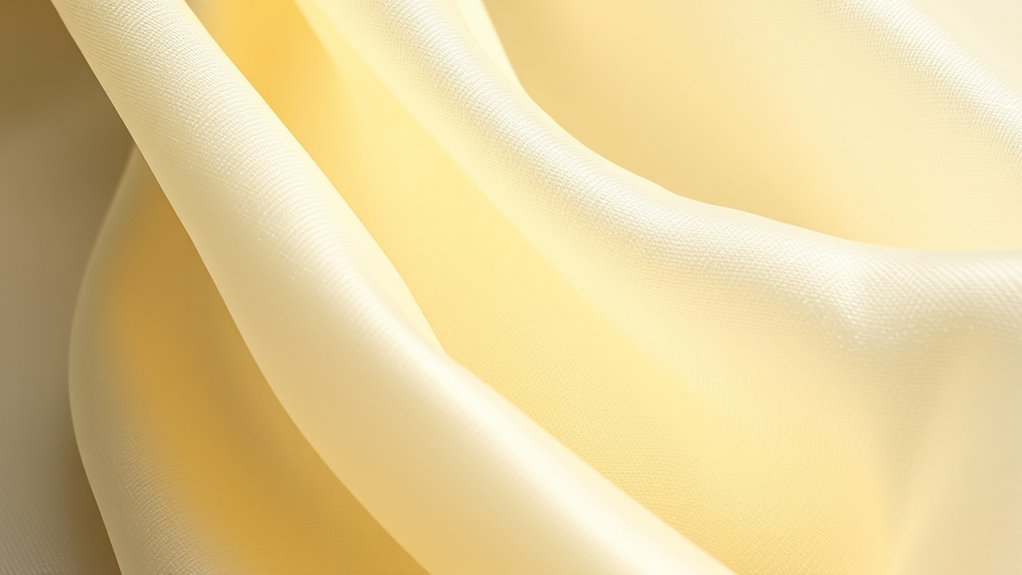
To keep silk looking vibrant and maintain its brightness over time, proper care and handling are essential. Avoid exposure to direct sunlight, which can accelerate dye migration and cause color fading. Wash silk gently in cold water with a mild detergent and avoid harsh chemicals. Store it in a cool, dark place to prevent yellowing and preserve its brightness. Use acid-free tissue when storing to prevent any chemical reactions. Additionally, understanding environmental considerations helps in choosing the best storage and care practices to extend silk’s natural luster. Proper environmental conditions, such as controlling humidity and temperature, also play a significant role in preventing material deterioration over time. Being aware of climatic influences is crucial for maintaining silk’s integrity and appearance in the long term. Ensuring the right storage environment minimizes exposure to pollutants that can cause discoloration.
Frequently Asked Questions
Can Certain Optical Brighteners Be Safer for Silk Than Others?
You wonder if some optical brighteners are safer for silk than others. Certain brighteners are designed to minimize dye absorption, reducing the risk of yellowing over time. Safer options maintain fiber strength and prevent damage, ensuring silk stays vibrant longer. By choosing brighteners with gentle formulations, you help preserve the delicate silk fibers and avoid harsh chemicals that could lead to deterioration or discoloration.
Are There Natural Alternatives to Optical Brighteners for Silk?
Imagine restoring a vintage silk scarf with a gentle touch—that’s what natural alternatives can do. Instead of chemical optical brighteners, you can use eco-friendly treatments like natural dyes or botanical extracts. These options brighten silk without yellowing over time, preserving its beauty and integrity. Natural dyes not only enhance silk’s appearance but also offer a safer, sustainable way to achieve that luminous look, making your silk timeless and eco-conscious.
How Does Storage Temperature Affect Silk’S Yellowing Process?
You should consider how storage temperature impacts silk’s yellowing process. Higher temperatures accelerate chemical reactions, increasing the rate of yellowing, while cooler conditions slow this down. Proper storage conditions, such as keeping silk in a cool, dark place, help prevent discoloration over time. Avoiding heat and direct sunlight is key to maintaining silk’s natural color, ensuring it stays vibrant and less prone to yellowing caused by environmental factors.
Do Different Silk Types React Differently to Optical Brighteners?
Think of different silk types like various musical instruments, each reacting uniquely to optical brighteners. Your fiber composition influences how silk absorbs dye and brighteners, affecting yellowing over time. Some silks, like mulberry silk, have a dense fiber structure that absorbs brighteners differently than wild silk. This variance causes different reactions, with some silks yellowing faster while others stay brighter longer. Understanding your silk’s fiber composition helps you choose proper care to prevent yellowing.
Can Washing Methods Reverse or Prevent Yellowing Caused by Brighteners?
You can often prevent or reduce yellowing caused by optical brighteners through proper washing techniques and choosing the right detergent additives. Use gentle, cold or lukewarm water, and avoid harsh detergents with unnecessary chemicals. Opt for detergents free of optical brighteners or specifically designed for delicate fabrics like silk. Regularly washing with appropriate techniques helps maintain silk’s natural sheen and minimizes the yellowing effect caused by certain brightening agents.
Conclusion
So, when optical brighteners turn your silk’s delicate shine into a dull, yellowed whisper, it’s like watching a moonlit river fade at dawn. To keep your silk gleaming like new, treat it with care and avoid prolonged exposure to harsh chemicals. Think of your silk as a treasured secret—nurture it gently, and it’ll continue to shimmer like a star in the night sky, preserving its luminous beauty for years to come.
